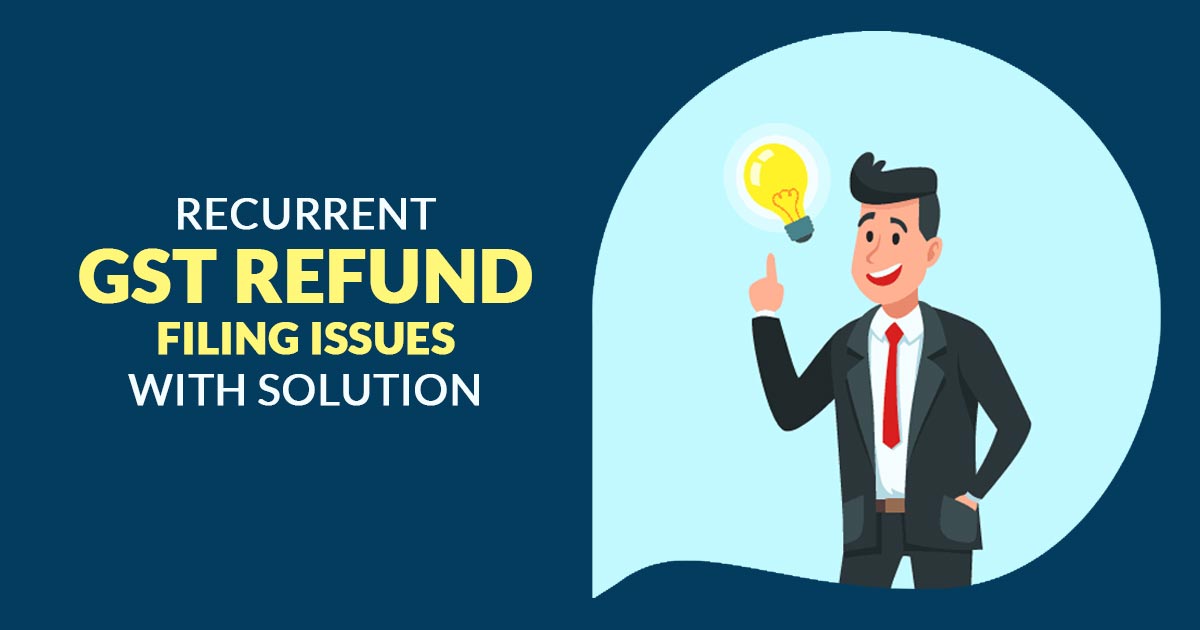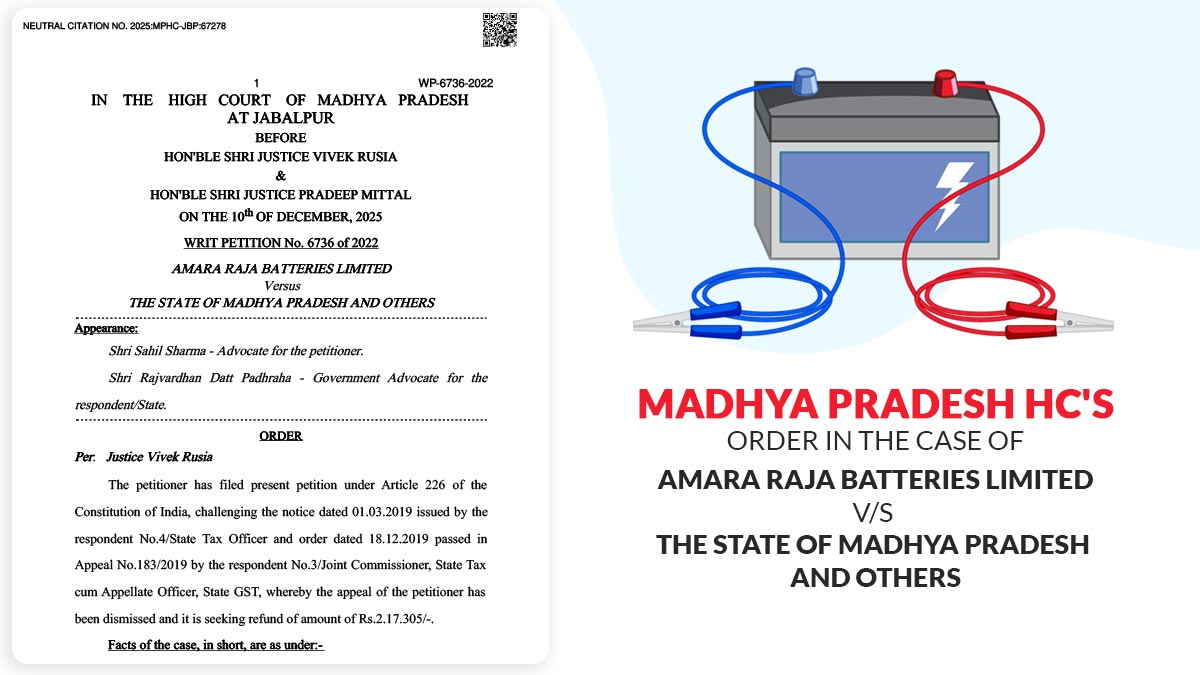
The problems suffered by the registered dealers during furnishing the refund applications have no limit from the limitation time, interest on the late refund, and others. Which reveal their place in Tribunals and courts. In this, we have attempted to list some of the common problems suffered during filing the GST refund applications beneath the GST provision.
GST Refund for Tax Paid Under Wrong or Correct Section
Issue: what shall be the related date towards the computation of two years? Whether the date of tax filed beneath the wrong or correct head?
Solution As per the GST provision: Section 54 of Central Goods and Services Tax Act, 2017 (“CGST Act”), Para 2 the explanation precisely furnished the related calculation date of 2 years duration towards the paying the GST refund. While in the case not precisely mentioned the related date would be the tax payment date.
Indeed, section 77 of the CGST Act issues permission for a refund for the case of the tax furnished beneath the wrong head:
It furnishes the exemptions from the interest payment in which the IGST would file rather than CGST/SGST.
From an example let’s learn about the above problem:
M/s ABC Ltd. filed the tax beneath CGST/SGST head dated 25th September 2017, and later while paying the annual/audit beneath GST law realized tax must have been filed beneath IGST head on the date 20th February 2020. The Company wants to pay the GST refund for tax paid beneath the wrong head i.e., towards the CGST/SGST head and it files the correct tax beneath the IGST head on 20th February 2020.
According to the GST computation, the related date to pay the refund will be the payment date of tax which in the above cases is 25th Sept 2017. The refund would seek towards CGST/SGST that is filed wrongly and not towards the correct tax payment. As per that, no refund could be claimed if the amount complies with the time.
Closure: Relevant Date: Under the wrong head the tax payment date.
GST ITC Refund Where Goods and Services Exported without Tax Payment Under LUT
Issue: Input tax credit refund in which the enrolled individual exported the goods without the tax payment and obtained the foreign remittance but loses to furnish LUT. the time duration to file the LUT i.e 31st March of the corresponding year would lapse and no choice would then available online to furnish the LUT for the former year. Whether the GST Input tax credit (ITC) refund would be available? Any other process to take the refund.
Solution: According to the rule 96A of CGST Rules, 2017 the exports would be performed without tax payment in which LUT gets furnished. Now in which the individual delays towards LUT filing for the specific year, still the refund would be available according to the circular 125/44/19-GST on 18th November 2019.
The problem will remain to appear while the online portal does not permit LUT filing post 31st March of a precise year.
For instance: M/s ABC ltd would export the services from 1st August 2017 which is its date of registration without the tax payment beneath the LUT compliance. The same applies to the input tax credit refund for the FY 2017-18, 2018-19, and post to the completion of all export prerequisites, the proper officer (“PO”) credits the refund in the bank details shared via the registered individual.
Towards the Financial year, 2019-20 registered individual projects to furnish for the refund on the date of 15th April 2020. During document uploading, they realized LUT would not be furnished towards the FY 2019-20, while the exports would be processed without any tax payment. When individual attempts to furnish LUT the portal do not display the option to file LUT of the former year as the year has finished, after the date 31st March.
When no LUT got furnished then there are 2 methods for the refund beneath GST law:
Conservative Method
- Change the export invoices and classified them beneath the export with the tax payment that is changed invoices in the GSTR-1 and do the tax payment including with the interest in the GSTR-3B of April following the mentioned example. After that, the enrolled individual might furnish to avail the tax refund beneath the export with the tax payment.
Liberal Approach
- According to the circular, the delay would not be specified in the furnishing of LUT and does not be ruled as a cause of the non-sanctioning of the refund. The fact is that when the GST portal does not permit the filing of LUT after the fiscal year, the taxpayers must apply for LUT through offline mode.
As per that, the refund would not be applied to the input tax credit for making cash outflow and then avail the refund of the tax filed.
Closure:
- Approach 1: Pay IGST with interest and claim a refund of tax paid on exports
- Approach 2: File LUT manually and furnish the refund of the Input tax credit in which the exports incurred without tax payment.
- Approach 1: File the GST with interest and claim a refund of tax paid on exports
- Approach 2: File LUT manually and pay a refund of Input tax credit where exports were made without payment of tax.
Non-receiving of Foreign Remittance Where the Major Conditions Applicable for Claiming of ITC in Case Exports Done Over Non-payment of Tax
Problem M/s ABC Ltd (India) used to furnish some services to M/s XYZ Inc. (Russia) during FY 2019-20. The duration to file the refund application would soon get lapse that is 2 years from the concerned date but the recipient of service i.e M/s XYZ Inc. would not be enabled to remit money because of the ongoing war condition. The duration to revamp the GSTR-1 form would lapse with tax payment through which the petitioner can avail the tax filing on the export services beneath the export with the tax payment. Through what approach does the enrolled individual proceeds to furnish the GST refund in this condition?
Solution: The government attempted to talk with the countries to function the banking system that will enable the importers to remit the money within a specific time. Moreover, the SC extension order on the date 23rd March 2020 that furnished for the prolonged timeline for the appeals could be desired to explain the cause of the late filing of a claim for the refund.
Closure
Resort to relief given via SC to furnish the petition for the refund.
What does it mean for the limitation period in the event of a deficiency memo?
Problem: Council has provided the deficiency memo, rendered to lead half refund to become time-barred. How to overcome the situation in which an initial refund was furnished for the duration of 2 years from the related data?
Solution: According to section 54 refund would be allotted in 2 years from the related date and Rule 90 (3) needs a new filing of refund application in which the deficiency memo is given.
The council post investigating the refund application provides the deficiency memo within 15 days of furnishing the refund application. The deficiency memo shows that the document would not be in place to be noticed as a mismatch in the refund filing application.
While the new application would be pointed to delay in filing of the refund application in some cases where it rendered to the limiting part of the refund because of the non-filing in 2 years from the related date.
Example: M/s ABC Limited furnished the refund application for the duration of 1st April 2020 to 31st March 2021 on 15th March 2022. Now, deficiency memo is given on 31st March 2022 and refund is time-barred if a new application would get furnished dated 15th April 2022 for the part 1st April 2022 to 15th April 2022 as beyond 2 years from the related date.
Various rulings on the issue furnished with thTaxTaxe High court, Jian International Vs CGST, 2020-VIL-328-Del where Delhi HC cancelled the department’s request and ruled that permitting the council to provide the deficiency memo would be directed to the rejection of the application, which leads to the impact on the limitation period and interest.
Closure: As per that, the enrolled individual must approach the courts with the ready documentation to confirm the refund becoming time-barred because of the deficiency memo.
What is the Limitation Period for Appeals of Refunds?
Problem: What will be the date for calculation of the last date of refund filing
Solution: According to Section 54 of the CGST Act, 2017 and identical provisions in Customs Section 27 and Central Excise in Section 11B, file a refund under one or two years from the order date.
The issue for the computation of the date of the final order, if that would need to compute from the first favourable order or the final order is litigated for a long time.
For instance: M/s ABC Ltd (“Taxpayer”) filed for a refund appeal (period FY 2018-19) and obtained a favourable order dated 25th Sept 2020 that was opposed by revenue. Hence an assessee seeking the final order waits to file the refund application. On the date 10th, June 2021 the final order was obtained in favour of the assessee.
Now the assessee does not furnish the refund application dated 25th September 2020 when the initial order was given on the date 20th Sept 2022 which becomes time-barred as per the dept.
Refer to the below judgment permit for the refund application furnished on the 20th of September 2022:
The problem is taken up by Gujarat High Court which placed support on the case of Dena Snuff (P) Ltd. Vs CCE [2003 (157) ELT 500 SC] specified that the case reached finality only on the Final Order and permitted paying the refund application directing Revenue to provide the refund.
Closure: As per that the filing date of the refund application would be recognized through the date on which the final order is provided via revenue.
The mentioned above outlines some of the common recurrent problems suffered via enrolled individuals beneath the refund filing of GST. The filing procedure would become avail in the digital world still there are problems that stayed unresolved and required to be addressed to prevent the refund blockage.









